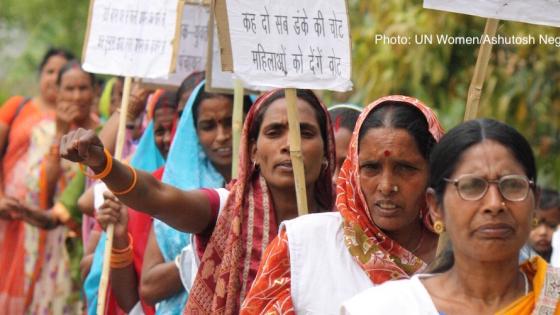Despite women constituting half the world’s population, they account for less than a quarter of the membership of national parliaments globally. Such descriptive or numerical under-representation can have consequences for substantive representation of women’s interests. Previous research has shown that, in many instances, greater political participation by women does result in policy choices more attuned to women’s needs and concerns (Chattopadhyay and Duflo 2004, Miller 2008, Iyer et al. 2012). Moreover, having more women in elected office has been shown to lead to broader societal benefits such as better infant mortality rates (Bhalotra and Clots-Figueras 2014), better education outcomes in urban areas (Clots-Figueras 2012) and lower corruption (Brollo and Troiano 2016).
In this column, I examine some of the causes behind the low representation of women in political office, whether the examples of some women winning elections can create a virtuous cycle of greater women’s representation in future, and whether gender quotas can be an effective way to increase women’s political voice. Most of the evidence I review comes from India, the world’s largest democracy, though many of these facts and findings generalise to the US, the world’s second largest democracy.
Explaining the low political candidacy of women in India
The lack of women political candidates is a potentially critical barrier to their eventual representation in government. For instance, in India’s recently concluded 2019 national election, about 14% of those elected to parliament were women (Jensenius and Verniers 2019). But only 9% of the candidates were women! So, conditional upon contesting, women exhibit somewhat stronger chances of winning than men. The same holds true at the state level too. We analysed data from India’s state assemblies over 1980-2007 and found that while women comprised 5.5% of all state legislators over this period, only 4.4% of the candidates were women. In the US, women held 24% of the seats in Congress in 2019, while about 29% of candidates in the 2018 midterm elections were women. In contrast to this large gender gap in candidacy, there is no gender gap in voting in India, with women turning out to vote at the same rates as men in state and national elections after 2010. In the US, women’s voter turnout has been higher than that of men since 1970.
What might explain the low political candidacy of women? In a survey conducted in India’s largest state of Uttar Pradesh, we find that women are also much less likely to report being part of other electoral activities such as participation in campaigns, listening to candidate speeches, or membership in political parties (Iyer and Mani 2019). We found that women lag behind on several potential determinants of political participation, such as knowledge about how political institutions work, their self-assessed leadership skills, and their voice in key household decisions (for example, only one-third of women report having a high level of input into household repair decisions). A similar ‘ambition gap’ has been documented for women in the US, despite their much higher levels of education and labour force participation compared to India (Lawless and Fox 2010). Women in rural India also face significant mobility restrictions (for example, 46% of women in our survey report requiring permission even to go to nearby places such as a friend’s house), while women in urban India often forgo important opportunities due to concerns about safety (Borker 2018). All of these factors, together with education, household wealth and religion or caste, can explain approximately 69% of the gender gap in electoral political participation. This suggests that improving women’s knowledge, self-confidence, voice and mobility can have significant effects on their political participation.1
Is there a role model effect?
Could we then generate a ‘virtuous cycle’ whereby women winning a few elections would then increase the self-confidence of potential women candidates (via a role-model effect) and thereby increase women’s candidacy in the next election? Alternatively, voters may initially have been apprehensive about the idea of a woman representative, having rarely seen one before. After experiencing a woman representative, they may become more comfortable with voting for women candidates next time. Similarly, party leaders may be more willing to nominate women candidates after observing their electoral success.
We set out to examine whether such a role-model effect exists by examining women’s electoral success and subsequent female candidacy in India’s state-level elections (Bhalotra et al. 2018). We put together data on 3,473 electoral constituencies over the three-decade period from 1980 to 2007. State governments in India’s federal system have considerable authority over several policy domains, including law and order, health, and education. If we simply compare female candidacy in constituencies previously won by a woman to constituencies won by men, it may not be a valid comparison. For instance, in places where women win, voters might be more woman-friendly to begin with and that may encourage female candidacy, irrespective of whether the woman or lost. In other words, we would be picking up differences in voter preferences rather than any demonstration effect of women’s electoral success.
We therefore perform a regression discontinuity analysis, comparing electoral constituencies in which a woman won narrowly against a man to those in which a man won narrowly against a woman. The premise is that in areas with mixed-gender close elections, those in which a women wins are very similar to those in which a man wins, and that the outcome of such close elections is decided by ‘quasi-random’ idiosyncratic factors.
We document three important findings. First, we find that a woman’s electoral victory leads to an 18.5 percentage point higher probability of having a woman major party candidate in the next election. This is completely attributable to an increased propensity of the incumbent woman to stand for re-election. Disappointingly, we find no evidence that new women are encouraged to contest. However, we should note that the (woman) incumbent obtaining her party’s nomination for re-election is an important achievement in Indian politics, where 34% of female incumbents and 28% of male incumbents do not contest for re-election despite there being no term limits.
Second, there are no spillover effects of observing a woman’s victory: other parties do not switch to fielding women candidates, and there is no increase in female candidacy in nearby constituencies.
Third, we find some evidence of a ‘backlash’ effect for new women candidates. In states where gender bias is known to be deeply entrenched (we proxy this by the share of women in the population, a lower share being indicative of sex-selective abortions and/or neglect of women’s health), a woman’s electoral victory is followed by a significant decline in the share of new women candidates in the next election. We investigated whether our results might be explained by a shortage of potential women candidates by exploiting a 1993 constitutional amendment that mandated a gender quota, with one-third of all seats in village and district councils being set aside for women. This created a very large pool of women with at least some experience of politics and governance. We do not find larger candidacy responses to women’s electoral victory at the state level after this change was implemented, so it seems that a shortage of potential women candidates cannot explain our results.
This lack of a demonstration effect is not specific to India, or to women. In our own analysis, we find a very similar pattern of results for Muslims, who are a religious minority and considerably under-represented in political office, despite their presence making a positive difference to health and education outcomes (Bhalotra et al. 2014). There is no entry of new Muslim candidates following a Muslim’s electoral victory, and the candidacy response is more negative in states in which Muslims form a smaller share of the population. In the US, where incumbents almost always win re-election, Broockman (2013) nevertheless finds that women’s electoral victories have no impact on future women’s candidacy in nearby constituencies.
The impact of quotas
More than 100 countries have implemented some form of gender quotas in an effort to improve women’s representation in leadership positions. While these may provide descriptive representation, the evidence is mixed on how well quotas can improve future women’s political participation. Our survey in Uttar Pradesh found that the presence of women village leaders had no impact on any measures of electoral participation for women (Iyer and Mani 2019). In a non-political context, seven years after Norway implemented a 40% gender quota for corporate board members, there was no change in female enrolment in business education programmes (Bertrand et al. 2019). Other studies are more encouraging – de Paola, Lombardo and Scoppa (2010) document increased political participation of women in Italy after a short-term gender quota in local government. Perhaps quotas need a longer time to work – data from India’s West Bengal state show that women’s political candidacy increases, and young girls are more likely to view themselves in leadership roles, only after a village council has been headed by a woman for two consecutive terms (Beaman et al. 2009, 2012). More research is needed on when and how gender quotas can be more effective, and on non-quota alternatives to improving women’s political participation.
References
Beaman, L, R Chattopadhyay, E Duflo, R Pande and P Topalova (2009), “Powerful women: does exposure reduce bias?”, Quarterly Journal of Economics 124(4): 1497–540.
Beaman, L, R Chattopadhyay, E Duflo, R Pande and P Topalova (2012), “Female leadership raises aspirations and educational attainment for girls: a policy experiment in India”, Science 335(6068): 582–6.
Bertrand, M, S E Black, S Jensen and A Lleras-Muney (2019), “Breaking the Glass Ceiling? The Effect of Board Quotas on Female Labour Market Outcomes in Norway”, Review of Economic Studies 86(1): 191–239.
Bhalotra, S, G Cassan, I Clots-Figueras and L Iyer (2014), “Religion, politician identity and development outcomes: evidence from India”, Journal of Economic Behavior and Organization 104: 4–17.
Bhalotra, S and I Clots-Figueras (2014), “Health and the political agency of women”, American Economic Journal: Economic Policy 6(2): 164-197.
Bhalotra, S, I Clots-Figueras and L Iyer (2018), “Pathbreakers? Women’s Electoral Success and Future Political Participation”, Economic Journal 128 (613): 1844-78.
Borker, G (2018), “Safety First: Perceived Risk of Street Harassment and Educational Choices of Women,” Working paper.
Brollo, F and U Troiano (2016), “What happens when a woman wins a close election? Evidence from Brazil”, Journal of Development Economics 122: 28-45.
Broockman, D E (2013). “Do female politicians empower women to vote or run for office? A regression discontinuity approach”, Electoral Studies 34: 190–204.
Chattopadhyay, R and E Duflo (2004), “Women as policy makers: evidence from a randomized policy experiment in India”, Econometrica 72(5): 1409-1443.
Clots-Figueras, I (2012), “Are female leaders good for education? Evidence from India”, American Economic Journal: Applied Economics 4(1): 212-244.
de Paola, M, R Lombardo and V Scoppa (2010), “Can gender quotas break down negative stereotypes? Evidence from changes in electoral rules”, Journal of Public Economics 94(5–6): 344–53.
Iyer, L and A Mani (2019), “The Road Not Taken: Gender Gaps Along Paths to Political Power”, World Development 119: 68-80.
Iyer, L, A Mani, P Mishra and T Topalova (2012), “The Power of Political Voice: Women´s Political Representation and Crime in India", American Economic Journal: Applied Economics 4(4): 165-193.
Jensenius, F R and G Verniers (2019), “Indian National Election and Candidates Database 1962 - Today”, Trivedi Centre for Political Data.
Lawless, J L and R L Fox (2010), It Still Takes A Candidate: Why Women Don´t Run for Office, Cambridge University Press.
Miller, G (2008), “Women’s suffrage, political responsiveness, and child survival in American history”, Quarterly Journal of Economics 123(3): 1287–327.
Endnotes
[1] Interestingly, Iyer and Mani (2019) find that gender gaps in non-electoral political participation (activities such as attendance and participation at village council meetings, interactions with public officials at the village, block or district level and involvement with public petitions) are much larger than the gender gaps in electoral political participation. The factors listed above explain only 42% of the gender gap in non-electoral political participation.



